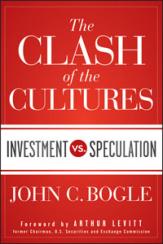
In his new book, “Clash of the Cultures: Investment vs. Speculation” to be released in August by John Wiley & Sons, Bogle explains how, over the past several decades, the fund industry has veered further and further off its original path of long-term investing to a culture of short-term speculation. The consequences for investors, says Bogle, have been devastating. In a refreshing turnabout for a fund manager, Bogle points the first finger of blame at his own early mistakes while CEO of the Wellington Fund in the late 1960s and shares his insights in a detailed case study.
Bogle first appeared within the pages of Institutional Investor in the January 1968 cover story, “Whiz Kids Take Over at Wellington.” The article, written by editor George Goodman — who, under the nom de plume Adam Smith, later wrote “The Money Game” — recounts how a longtime balanced mutual fund company Wellington Fund, succumbed to the riskier equity investment frenzy of the late 1960s. When Wellington brought a group of young turks from Boston led by Robert Doran to run an equity-heavy fund, “we totally failed,” recalls Bogle. “We tried to make a balanced fund into a go-go fund at the worst time in history to do so.”
Bogle’s new book picks up where Goodman’s 1968 article left off, describing the steep price paid by the former “blue-chip” balanced equity fund, and how the mutual fund leader picked up the pieces and moved on to great success. It’s an eye-opening read for anyone interested in the inner workings of a fund company. An excerpt from Chapter 8, "The Rise, the Fall and the Renaissance of Wellington Fund” follows. -- Fran Denmark
The Fall: Wellington Fund’s Nadir – 1967-1978
It was too good to be true, at least for Wellington Fund. Our bullish and innovative new managers had set out to “modernize” Wellington Fund. Inappropriate as it may seem today, Wellington joined the new speculative parade. Walter M. Cabot became the Fund’s investment director in 1967. (He would leave the firm in 1974 to become president of Harvard Management Company, running the college’s huge endowment fund. He remained there until 1990.) Cabot had left the Putnam fund organization to join Wellington Fund’s partners in 1967, Acting quickly, he had raised the equity ratio from 62 percent in 1966 to 72 percent in 1967, and finally to an all-time high of 81 percent in 1972. Here’s how Cabot described the change in philosophy in the Fund’s 1967 Annual Report:
"Change is a starting point for progress, and 1967 was a year of change for Wellington Fund. Obviously, times change. We decided we too should change to bring the portfolio more into line with modern concepts and opportunities. We have chosen “dynamic conservatism” as our philosophy, with emphasis on companies that demonstrate the ability to meet, shape and profit from change. (We have) increased our common stock position from 64 percent of resources to 72 percent, with a definite emphasis on growth stocks and a reduction in traditional basic industries.
A conservative investment fund is one that aggressively seeks rewards, and therefore has a substantial exposure to capital growth, potential profits and rising dividends . . . (one that) demands imagination, creativity, and flexibility. We will be invested in many of the great growth companies of our society. Dynamic and conservative investing is not, then a contradiction in terms. A strong offense is the best defense."
Cabot, encouraged by our other fund’s new managers, took an aggressive stance that was without precedent in the Fund’s long history. The traditional Beta in the 0.65 range rose into the high 0.70s, and then into the 0.80s. In a single year—unfortunately, right at the market’s peak in 1972—the Fund’s Beta reached a record high of 1.04. The once-conservative balanced fund was taking on greater risk than the stock market itself. Contributing to this risky position, the equity ratio had gradually risen from that earlier conservative norm of 62 percent to an all-time high of 81 percent as 1972 ended. The sharp increase in risk exposure was followed by a major bear market in stocks. The Standard and Poor’s 500 Index fell by 48 percent and the Fund’s asset value fell by 40 percent—nearly 80 percent of the decline in the Index, a shocking excess relative to Wellington’s long history. The loss would not be recouped until 1983, eleven long years later. The “strong offense” proved no “defense” at all.
Rather than improving the Fund’s record, the about-face in the Fund’s character devastated it. Even as the market rose during 1967-1972, our cumulative return lagged that of our balanced fund peers by fully 30 percentage points (cumulative gain of 38 percent versus 68 percent for our peers). We didn’t do any better during 1973-1978, which encompassed the great bear market and the partial recovery that followed, lagging our peers by another 12 percentage points (13 percent gain versus 25 percent gain for our peers). We had brought in new managers as partners to improve the lagging performance that Wellington had delivered during the early 1960s, but we had succeeded only in making it worse. There is, of course, a profound lesson here!
In short, the conservative “blue-chip” Wellington Fund had indeed changed the color of its spots. It increased both its equity position and its risk exposure far beyond its traditional levels; it increased its exposure to stocks with below-investment grade quality and stocks selling at historically huge market valuations, in favor of less seasoned companies; it increased its focus on the short-term, with annual portfolio turnover doubling, from 20 percent to 40 percent (a high figure in that ancient era). Investment, alas, took a back seat to speculation. This change in the Fund’s character alarmed me, and I wrote a sharply-worded memorandum to our investment executives, warning them about both the excessive risks and their all too unhappy consequences.
Cabot responded promptly. He didn’t agree with me, nor did he accept my conclusions. I found his response totally unsatisfactory, indeed barely responsive to the issues raised in my 8-page memorandum. But the Wellington Fund problem was hardly the only problem created by the newly-merged firm. In the bear market, Ivest Fund collapsed, along with three other similarly speculative funds we had created to share in the blessings of a “New Era” that never came into existence. (None of these four funds survived.) Our fund and counsel assets plummeted, and the once-happy partners of that original merger had a falling out. While these partners held the prime responsibility for our investment activities, it was they who fired me in January 1974. It was not a happy moment in my career.
During this era, the Fund’s competitive shortfall grew ever greater, and the cumulative value of that initial $1.00 invested in Wellington at the outset, $11.40 at the end of 1966, rose to $15.76 at the 1972 peak, only to tumble to a mere $11.43 at the close of 1974, hard hit by the decline and by the new and risky strategy adopted seven years earlier. In the ensuing recovery, the gap got still worse, with Wellington underperforming its peers in five of the next six years. By the time that 1978 mercifully ended, the shortfall had reached boxcar proportions: cumulative value of that initial 1928 $1.00, Wellington $17.78; average balanced fund, $25.20. For a moment, I entertained the idea that we should simply merge Wellington Fund, once the Grand Old Lady who was the paradigm of our high standing in the industry, into another of our funds, and get on with our business. But I couldn’t do it. Rather, I would do whatever was necessary to restore Wellington to her former grandeur.
1978-2012 – The Renaissance
After that ghastly combination of terrible market conditions, a vastly diminished asset base, the collapse of our aggressive growth funds, and the demise of Wellington Fund’s performance, there seemed no way out. Yet deeply disguised, lay the opportunity of a lifetime. For while I was “out” as Wellington Management’s chief executive as 1974 began (as described in Chapter 4), I remained “in” as chairman and president of Wellington Fund and its sister funds, in a position of surprising strength.
In September 1974, after eight months of laborious study and give-and-take, I was able to persuade the Fund directors to retain me in my posts and build a small staff to administer the accounting, shareholder record-keeping and legal affairs of Wellington, and the other funds in what had become referred to as “The Wellington Group.” We formed a new corporation to handle these responsibilities, wholly owned by the eight funds themselves and operating on an at-cost basis—a truly mutual mutual fund structure, without precedent in the mutual fund industry. The name I chose for the new firm (as readers now must know) was, The Vanguard Group, Inc. On September 24, 1974 Vanguard was born.
Under the new structure, the funds’ staff would also oversee and evaluate the investment performance and marketing results of Wellington Management in its continuing role as adviser and distributor to the Vanguard funds. I was especially determined to return Wellington Fund to its roots, for I had failed, however unintentionally, to live up to Mr. Morgan’s confidence in me. He had hired me, trusted my judgment, and promoted me again and again, finally naming me to lead the company in 1965. I owed everything to that marvelous mentor. I could not let him down.
Restructuring Wellington Fund would be no easy task, but, with a helping hand from Princeton professor Burton Malkiel, who had joined our Fund boards in 1977, we got the job done, and recommended the new plan to the Wellington Fund directors. The board promptly approved it, and we directed Wellington Management Company to implement the restructuring.
Sometimes in life, we make the greatest forward progress by going backward. That is just what we did when we decided to take Wellington Fund back to its roots. Months later, the Board agreed to adopt my policy recommendations:
(1) hold the equity ratio firmly within a range of 60 to 70 percent of assets; (2) emphasize seasoned dividend-paying blue-chip stocks, largely of investment-grade quality and (3) sharply increase the Fund’s dividend income. Given the limits set by the Fund’s now mandatory position of 30 percent to 40 percent of assets in high-grade bonds, the new strategy would require the sale of many of the portfolio’s low-yielding growth stocks.
“Back to Basics”
When I gave these marching orders—especially our insistence in raising the Fund’s income dividend by fully 70 percent over the next five years (in fact, the increase was slightly larger than that)—to Wellington Management’s next choice to run the Fund’s portfolio, the late Vincent Bajakian was not pleased. He believed that growth stocks were the optimal choice, and that the emphasis on higher-yielding stocks would harm performance. Happily for the Fund’s shareholders, however, he signed on to the new strategy and implemented it well. The portfolio veered away from growth and toward value, and the Fund’s income dividends began a sharp and steady increase.
And as it turned out the actual annual dividends paid by the Fund during 1978-1983 were $.54, $.66, $.75, $.84, $.87, and $.92, astonishingly close to the original dividend projections in my memo—almost to the penny. Relative to Wellington’s average net asset value of $12.39 in 1983, that $.92 payment happened to represent a dividend yield of 7.4 percent for the fund. (Those were the long-gone days of generous yields. Today the Fund’s yield is 2.5 percent.) This new strategy had obviated the need ever to return to the old (and discredited by experience) “Six Percent Solution.”
Wellington Management Does the Job
Portfolio manager Vin Bajakian deserves great credit for adjusting to the new strategy and, by judicious stock selection, making it work so effectively for shareholders. His tragic death while flying his own airplane in 1995 could have been a major setback. But Wellington Management chose his partner, an investment veteran Ernst von Metzsch to succeed him, and, until his retirement in 2000, he continued to deliver returns under the new strategy that were generally superior to those of his balanced fund peers. Since then, under the management of Ernst’s successor, Edward Bousa, Wellington Management has done a fine job in continuing to effectively implement the income-oriented equity strategy adopted by the Fund back in 1978.
The Fund’s equity managers did their work well. And they were more than ably supported by Wellington’s bond managers, who maintained a fixed-income portfolio for which investment-grade quality continued to be the watchword. Paul Sullivan led these professionals during 1972-1995, ably succeeded by Paul Kaplan, and then by John Keogh. The bond managers also share in the credit for the Fund’s renaissance.
Wellington’s portfolio managers continue to reaffirm the merit of the strategy adopted by the Fund by the Board back in 1978. Here’s what they wrote to the Fund’s shareholders in the 2000 Annual Report:
. . . A reasonable level of current income and long-term growth in capital can be achieved without undue risk by holding 60% to 70% of assets in equities and the balance in fixed income securities. Consistent with this approach, dividend-paying stocks dominate the fund’s equity segment.
And in the 2010 Annual Report, manager Edward Bousa wrote:
We continue to search diligently for attractively valued companies with strong operating characteristics. We are particularly interested in the stocks of companies whose business fundamentals are poised to improve. As always, an above-average dividend is central to our stock selection process.
Clearly, Wellington Management has “signed on” to that strategy. Even better, over the past 35 years, both the strategy and its implementation have met the test of time.
Taking into account the new shares that shareholders received by the reinvestment of the substantial capital gains distributions paid by Wellington since its inception, the Fund’s income dividend totaled $0.94 per share in 1966. By 1977 it had increased only to $0.99, despite a 63 percent rise in the dividend of the S&P 500. When the new income-oriented policy was introduced in 1978, the Fund’s dividend income leaped ahead—in 1979 to $1.30, $1.72 in 1982; $1.88 in 1985; and to $2.19 in 1990.
In just twelve years, with the Fund’s bond position held constant in the 35 percent range, Wellington shareholders received a 110 percent increase in dividend income. Despite the decline in interest rates from their peak in 1981, Wellington dividends held fairly steady through 1995, before rising to a then peak-level of $2.74 in 1999. After a significant decline through 2003, the rise in dividend payments resumed, reaching $2.80 in 2008. Given lower interest rates and the substantial cut in corporate dividends in 2008, earning the dividend of $2.55 in 2011 seems a solid accomplishment. With its new strategy producing higher dividends, vastly improved performance, and careful control of risk, investors swarmed into the fund and it enjoyed an astonishing return to acceptance in the marketplace.
Asset Growth Rebounds
To say that the new strategy worked hardly captures the full extent of the Fund’s remarkable rebound from its shriveled asset base. Wellington enjoyed a soaring rise in assets—first, to a new record high of $2.4 billion in 1990, with growth, steadily continuing, year after year. As 2012 began, and assets reached an all-time peak of $55 billion, renaissance is hardly too strong a word to describe the change.
During the early part of the past quarter-century, the Great Bull Market had been the dominant force shaping the investment world. Despite Wellington Fund’s conservatism, the Fund gave a good account of itself relative to its peers in the long upsurge in stock prices through early 2000, and, given its conservative policies, an even better account during the ensuing painful bear markets, one in 2000-2003, the other in 2007-2009. With nice recoveries from both, and the good downside protection that had been our hallmark, Wellington had generated a cumulative 25-year total return of 886 percent during this challenging era, compared to 418 percent for its peers. Since the first bull market peak in 2000, Wellington Fund has actually generated a cumulative positive return of 90 percent—a remarkable testimonial to the value of a balanced fund, especially in a stock market environment that proved virtually stagnant.
Wellington Fund’s record of investment achievement is the result of three factors: (1) its investment policy and strategy, which is determined by the Fund’s management; (2) the accomplishments of its portfolio managers, who are selected by the Fund’s investment adviser, subject to the approval of the Fund’s directors; and (3) by the substantial advantage that the Fund has enjoyed by operating at costs dramatically lower than its peers. Vanguard controls the contract with the adviser, Wellington Management Company, which, with Vanguard’s approval, names the portfolio manager. The two firms negotiate to establish the fee rates applicable to the Fund’s assets. To get the best possible fee structure for Wellington’s shareholders, I confess to having been a demanding negotiator.
Strategy + Implementation - Cost = Superior Returns
Together, the combination of fund strategy, management tactics, and minimal cost has led to growth in each $1,000 invested when Wellington began operations in mid-1929 to an accumulation of $650,000 over the subsequent 83 years (through early 2012), compared to $440,000 for the average balanced fund—the magic of long-term compounding writ large. However, to use another favorite metaphor of mine: the long-term magic of compounding returns is all-too often overwhelmed by the long-term tyranny of compounding costs. Cost matters! Wellington Fund, uniquely among its peers, has minimized the impact of that tyranny, and its shareholders have prospered from that eternal magic.
Unarguably, it has been Wellington Fund’s substantial cost advantage vis-à-vis its peers that has been the powerful mainspring of its comparative advantage—its superior record. It is those minimal costs—the significant margin of cost advantage that Wellington has earned over its balanced fund peers—that have enabled the Fund’s cumulative return to explode over an 83-year span.
Despite the recent increase in advisory fees, described earlier, Wellington Fund’s total expense ratio, had declined from 34 basis points in 2003 to just 0.23 percent by 2011, largely because Vanguard’s consid¬erable economies of scale drove the Fund’s operating costs down from 29 basis points in 2003 to 16 basis points in 2011. On the other hand, the expense ratio of the average balanced fund, on the other hand, has gone up almost as fast as Wellington’s has gone down during that period, rising to a staggering 1.34 percent last year.
Result: Wellington now enjoys a truly awesome annual edge of 100-plus basis points - solely because of its low costs—an advantage of one full percentage point per year in extra return. Over its long history, with Wellington’s expense ratio averaging just 0.50 percentage points vs. 0.96 percentage points for its peers, today’s extra advantage at double that historical spread should auger well for the Fund’s investment edge in the years ahead. Yes, costs matter.
I’m certain that Walter Morgan would be pleased—indeed, delighted—with the renaissance of his beloved Wellington Fund. His vision has been fully realized. Such an outcome would have not seemed very likely 40 years ago, when the traditions he had established were ignored. But a return to sound balance in asset allocation, and a renewed focus on the Fund’s objectives of conservation of capital, reasonable current income, and profits without undue risk —originally stated way back in the 1930s—saved the day. Let all of us investors—and our institutional money managers—remember this history, learn from it, and celebrate it.
Excerpted from The Clash of the Cultures, by John C. Bogle, with permission from the publisher, John Wiley & Sons. Copyright (c) 2012.






